Start your business
Build your brand
Create your website
Online store editor
Customize your store
Store themes
Find business apps
Shopify app store
Own your site domain
Domains & hosting
Explore free business tools
Tools to run your business
Sell your products
Sell online or in person
Sell online
Grow your business online
Sell across channels
Reach millions of shoppers and boost sales
Sell in person
Point of Sale (POS)
Sell globally
International sales
Sell wholesale & direct
Business-to-business (B2B)
Market your business
Reach & retain customers
Market across social
Social media integrations
Nurture customers
Shopify Email
Know your audience
Gain customer insights
Manage your business
Track sales, orders & analytics
Measure your performance
Analytics and Reporting
Manage your stock & orders
Inventory & order management
Shopify Developers
Build with Shopify's powerful APIs
Plus
A commerce solution for growing digital brands
All Products
Explore all Shopify products & features
Help and support
Get 24/7 support
How-to guides
Read in-depth business guides
Shopify blog
Business strategy tips
What is Shopify?
How our commerce platform works
Founder stories
Learn from successful merchants
Branding
Build your brand from scratch
Marketing
Build a marketing plan
Ecommerce SEO
Improve your search ranking
Social media strategy
Turn social into sales
Business growth
Scale your business
Business name generator
Logo maker
Stock photography
Business plan template
Link in bio tool
QR code generator
Changelog
Your source for recent updates
Newsroom
All company news and press releases
Start selling with Shopify today
Start your free trial with Shopify today—then use these resources to guide you through every step of the process.
If you’ve decided to get into the food business as a first-time merchant, it’s a great choice—but you’re probably left wondering what comes next. With so many possibilities, the options are endless, but we’ve put together a few ideas to get you started.
Start your online business today.
For free.
Few industries are more vital than food. Tastes may change from person to person, but one thing’s for certain: everyone needs to eat.
The astronomically high volume of food lovers means there are a lot of potential customers. And a wide variety of product offerings means that no matter how many food retailers enter the market, there’s always room for one more.
If you’ve decided to get into the food business as a first-time merchant, it’s a great choice—but you’re probably left wondering what comes next. With so many possibilities, the options are endless, but we’ve put together a few ideas to get you started.
Every food business has advantages and disadvantages, so there’s no single “best” idea for everyone. This could become your full-time job, so you’ll want to consider your own interests and what you’re able to commit to, and choose the food business idea that’s best for you.
If you’re looking to get in to the food industry, here are 13 ideas for products and services you can use to get started: Food trucks have become an especially popular way to get into the food business. Right now, growth in food trucks is outpacing that of traditional restaurants, and it’s not hard to see why.
Food trucks have become an especially popular way to get into the food business. Right now, growth in food trucks is outpacing that of traditional restaurants, and it’s not hard to see why.
A food truck business can give a chef the same opportunity that they’d get with a restaurant to develop their own unique menu, but with the added benefit of mobility.
Getting customers through the door can be one of the biggest challenges that comes with owning a restaurant, so why not bring the restaurant to your customers?
Benefits
Challenges
Get inspired: Callie’s Hot Little Biscuit Callie’s Hot Little Biscuit is a grab-and-go eatery with locations in Charleston, Atlanta, Charlotte, and a food truck that travels all over the southern United States. Using its social media presence, it’s built a following of dedicated online fans.
Callie’s Hot Little Biscuit is a grab-and-go eatery with locations in Charleston, Atlanta, Charlotte, and a food truck that travels all over the southern United States. Using its social media presence, it’s built a following of dedicated online fans.
A post shared by Callie’s Hot Little Biscuit (@callieshotlittlebiscuit)
One of the great things about a food truck is that it doesn’t have to be the only source of income. Aside from keeping its followers informed of its event schedule, Callie’s Hot Little Biscuit also offers catering services and sells custom gift baskets online. Ice cream is one of the world’s most beloved deserts. In fact, the ice cream industry is expected to be worth $65.8 billion worldwide by 2026, meaning the industry is set to become increasingly profitable over the next couple of years.
Ice cream is one of the world’s most beloved deserts. In fact, the ice cream industry is expected to be worth $65.8 billion worldwide by 2026, meaning the industry is set to become increasingly profitable over the next couple of years.
Ice cream can be served alongside just about any other dessert and comes in a wide variety of styles, including frozen yogurt, sorbet, gelato, and frozen custard. With endless recipe ideas, ice cream is great for niching.
Benefits
Challenges
Get inspired: Sugar + Spoon
When recent University of Washington graduates Ivana Orlovic and William Hubbell developed an edible, egg-free version of cookie dough, they knew they were on to something. Sugar + Spoon creates rich, creamy treats by combining cookie dough and ice cream with a number of toppings and flavors.
A post shared by Sugar + Spoon Cookie Dough (@sugarspoondough)
Sugar + Spoon maintains a strong online following and sells out of its storefront in Seattle, as well as at pop-up shops, food truck events, and online. It even offers DIY ice cream packs, letting customers combine their favorite flavors into a single purchase. If you’re into a more hands-on personal approach to the food industry, then cooking classes could be just what you’re looking for. Teaching can be an extremely rewarding experience, and there’s no shortage of options when it comes to how you approach it.
If you’re into a more hands-on personal approach to the food industry, then cooking classes could be just what you’re looking for. Teaching can be an extremely rewarding experience, and there’s no shortage of options when it comes to how you approach it.
You could offer online courses or in-person classes. You might pre-record your courses and allow students to watch at their convenience, or do live one-night-only events for an online audience.
No matter your skill level, teaching others is a great way to hone your cooking skills and build personal relationships with your audience.
Benefits
Challenges
Get inspired: Nonna Live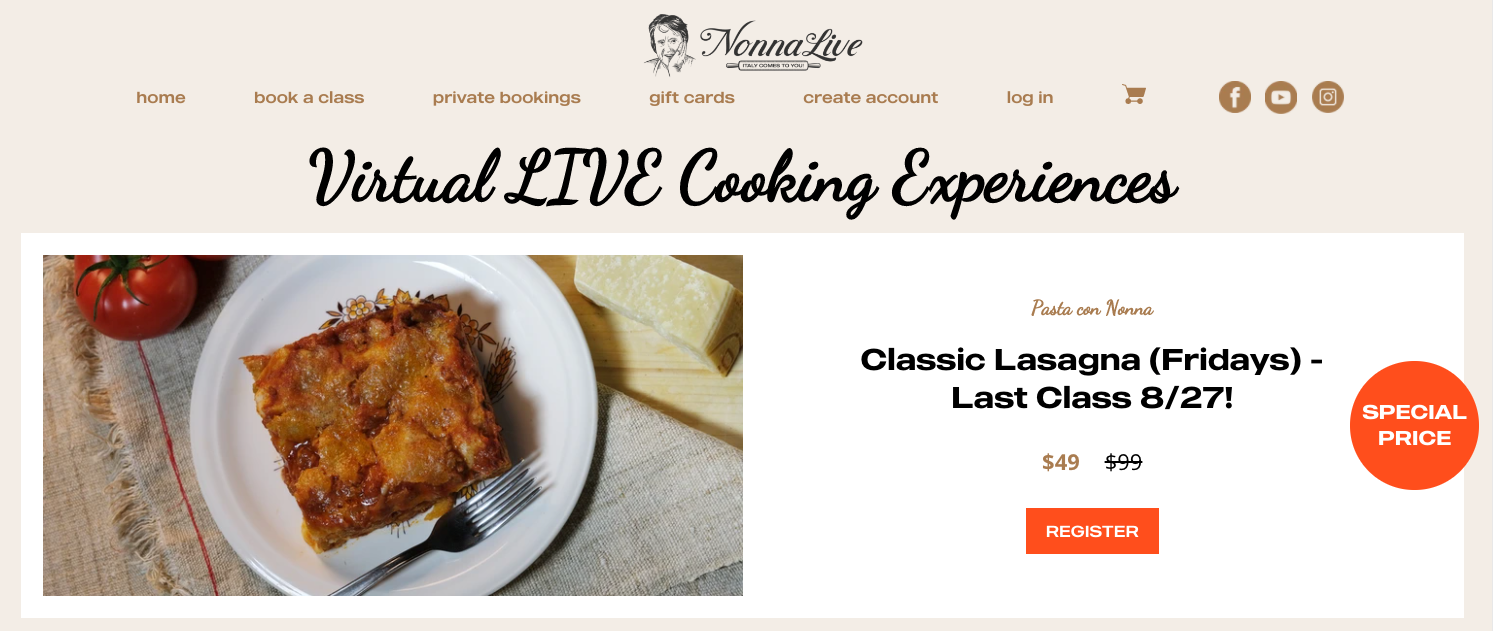
Each week, 84-year-old Nonna Nerina welcomes her audience into her kitchen in a small village in Italy via online video conferencing. When viewers tune in to Nonna Live, they’re transported directly to an authentic Italian kitchen and taught recipes that have been passed down for generations.
In Nonna Nerina’s online store, customers select a date and time and reserve their spot in a number of online classes. They’re provided a list of ingredients and supplies, and when the time comes, all of Nonna’s students gather for a live hands-on cooking lesson. 
If you’ve ever been in sales, you know the skills needed to build a personal relationship with your clients. If you’re looking for something in the food industry that offers that chance, then becoming a personal chef might be right up your alley.
Personal chefs are trained cooks hired to provide at-home meals for their clients, who often may have special dietary needs or preferences. They can be employed by individuals, families, or caterers, or for special events.
Benefits
Challenges Coffee is a vital part of our morning routines, so it should come as no surprise that the industry is expected to reach revenues of $155.64 billion by 2026. Coffee beans are widely available from dropshippers as well, meaning overhead costs can be kept low.
Coffee is a vital part of our morning routines, so it should come as no surprise that the industry is expected to reach revenues of $155.64 billion by 2026. Coffee beans are widely available from dropshippers as well, meaning overhead costs can be kept low.
There’s also a small-business advantage for first-time merchants who decide to sell coffee. Since it’s a widely available product, customers tend to value exclusivity when it comes to coffee, meaning they’re more receptive to new brands.
Benefits
Challenges
Get inspired: Steeltown Garage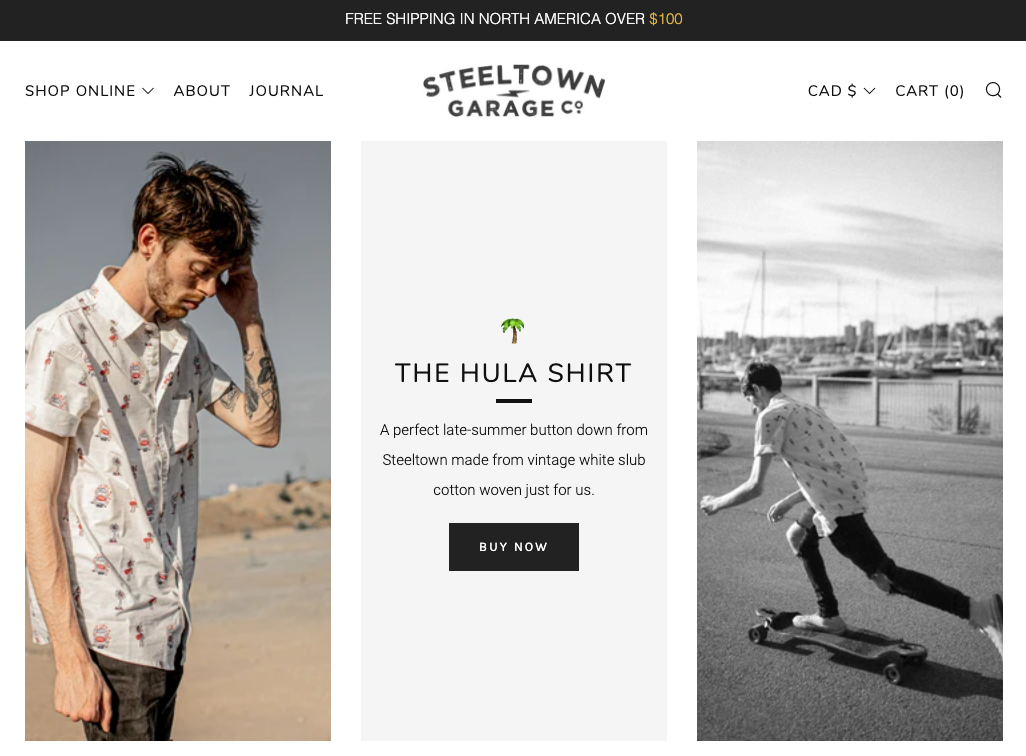
Steeltown Garage is a Hamilton, Ontario–based retailer of premium apparel and specialty coffee. At the start, Steeltown Garage sold graphic tees built around its freewheeling lifestyle brand. As the brand grew, so too did its products.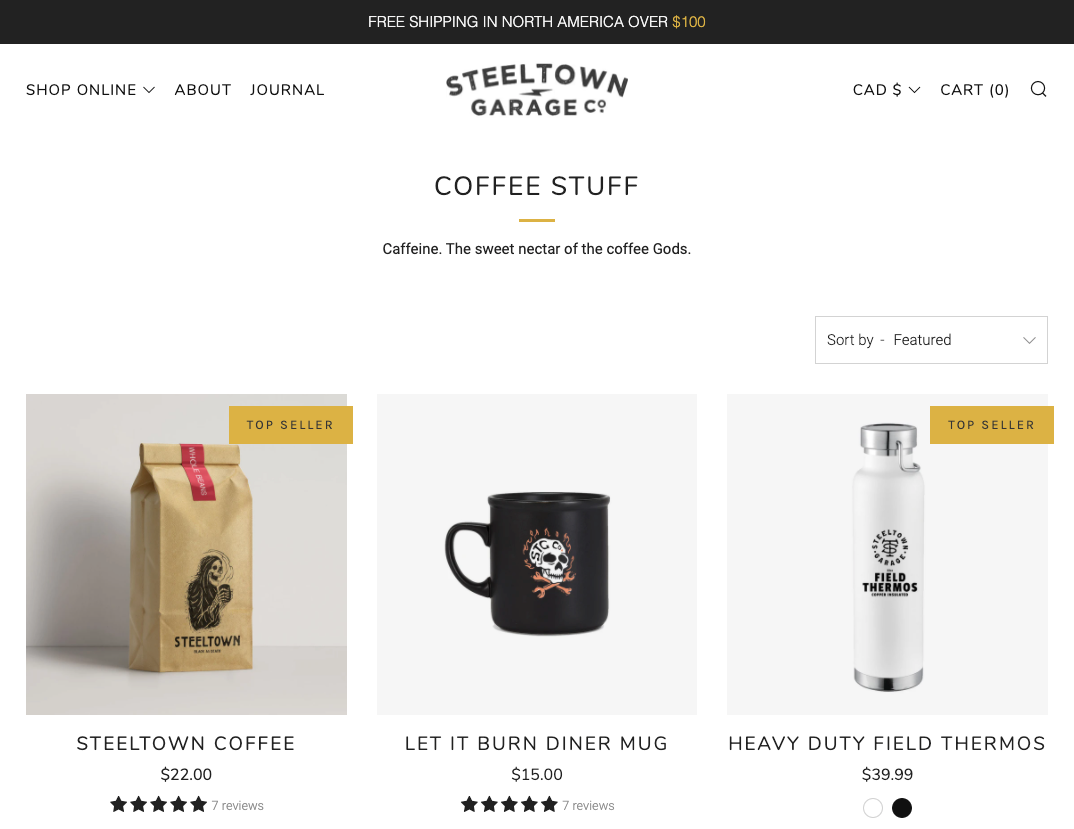
Steeltown Garage now sells a wide range of premium motorcycle-riding gear, grooming products, vintage art, posters, and, of course, coffee. Branding is vital when selling coffee, and Steeltown Garage understands this. Despite all of the products it sells, Steeltown Garage’s collections are harmonized around a brand that resonates with its audience. Meal kits are a type of food delivery service offering pre-portioned ingredients and recipes for creating high-quality dishes at home. They’ve grown increasingly popular over the last couple of years, aiming to combine the convenience of fast food with the quality of at-home cooking.
Meal kits are a type of food delivery service offering pre-portioned ingredients and recipes for creating high-quality dishes at home. They’ve grown increasingly popular over the last couple of years, aiming to combine the convenience of fast food with the quality of at-home cooking.
Meal kits can be sold on a subscription-based model, wherein retailers provide customers with a new meal on a recurring basis. Or you might create a collection of meal kits and sell them à la carte.
Benefits
Challenges
Get inspired: The Dough Bros
The Dough Bros is a wood-fired pizza restaurant operating out of Galway, Ireland. For customers that can’t make it to the restaurant, tThe Dough Bros offers ready-made pizza kits that come with all the toppings and sauces to make the brand’s signature slices at home.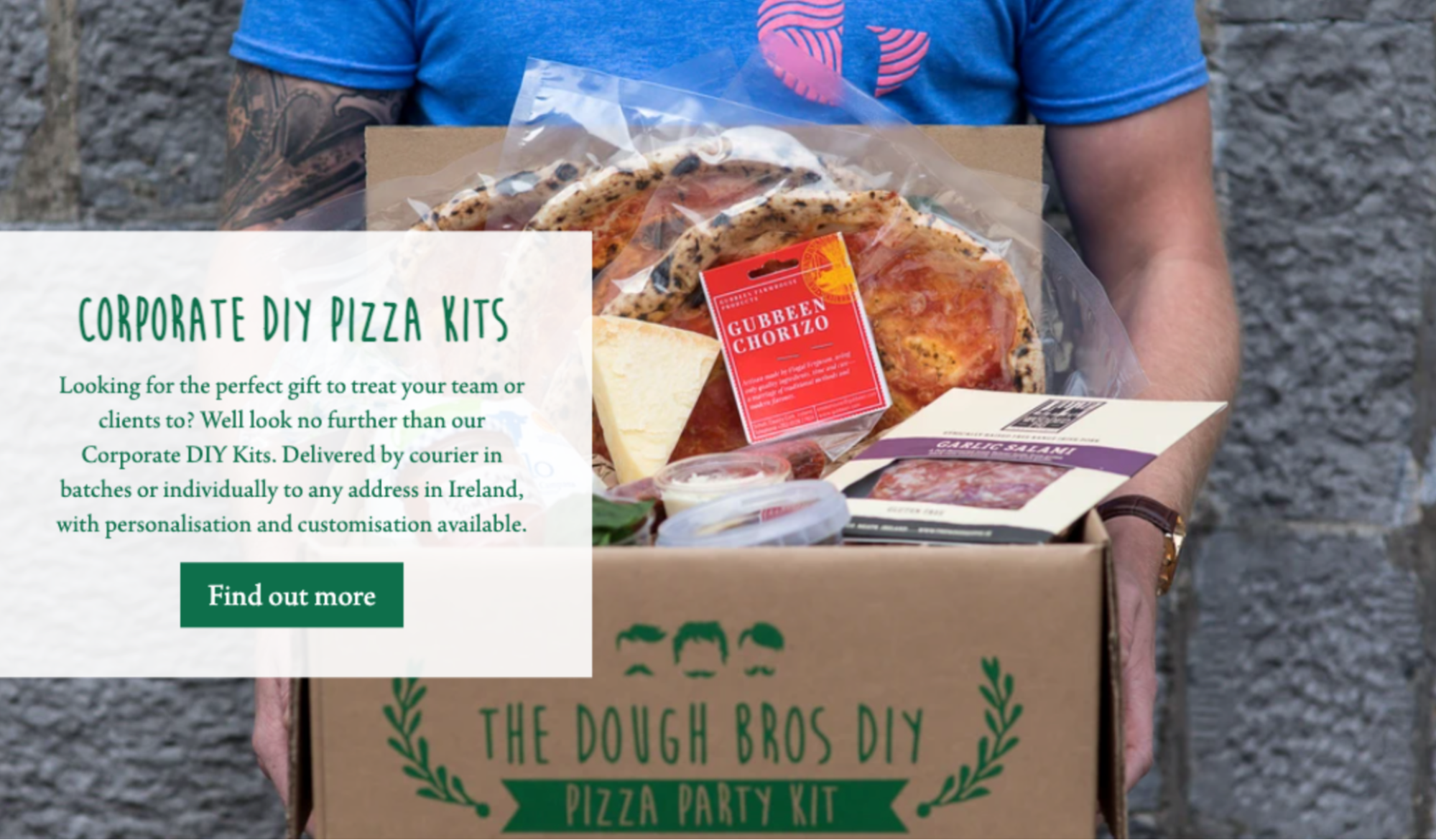
When it comes to meal kits, large brands may have more name recognition, but what they don’t have is a specialty. The Dough Bros’ branding works because it takes the beloved dish of pizza, enhances it with the meal-kit model, and immediately sets itself apart from larger brands.
Bakeries are one of the oldest types of food businesses. Baked goods have become a staple of holidays and special events, making them popular year round. Perhaps that’s why the baking industry generates more than $30 billion annually.
Selling baked goods can open a lot of other doors for your brand. You could sell baked goods for specific dietary restrictions, or specialize in something more specific, like bread, cookies, cakes, pastries, or pies.
Benefits
Challenges
Get inspired: Katz Gluten Free 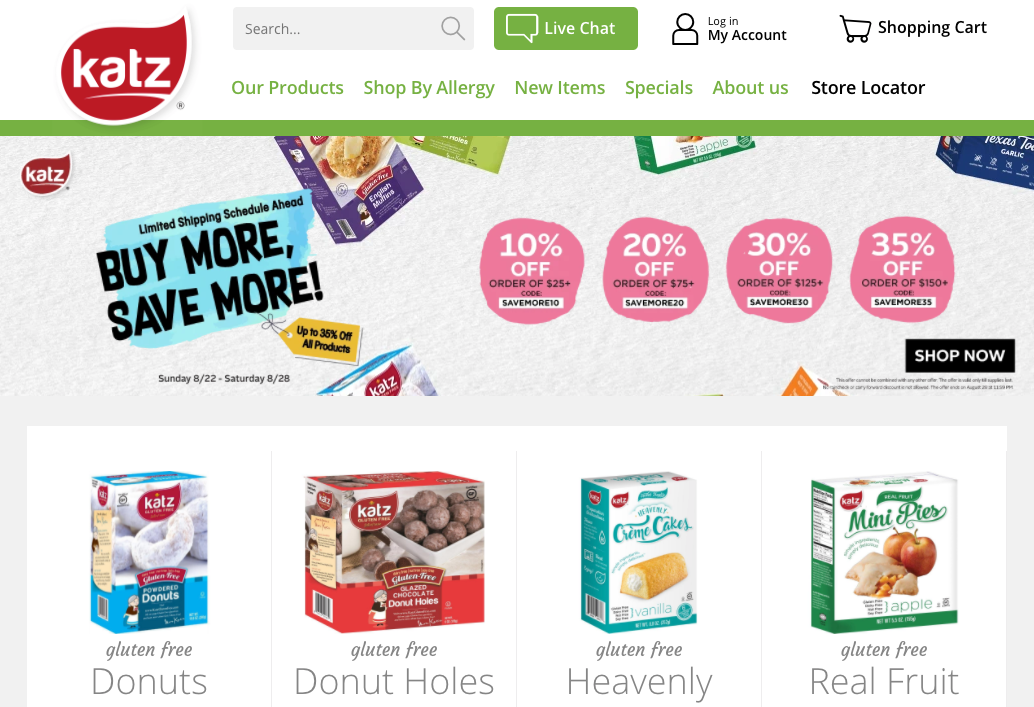
Katz Gluten Free specializes in baked goods for a wide range of allergies and dietary restrictions that might be harder to find in a grocery store. Katz’s variety is extensive—selling items such as whole wheat bread, cream-filled cupcakes, and apple fritters.
A post shared by Katz Gluten Free (@katzglutenfree)
Despite the selection of products, Katz is laser focused when it comes to its branding. Dietary restrictions can make shopping hard, but Katz stands out as a brand because it does everything in its power to make it easy. Katz’s website even has a special, “shop by allergy” tab that lets visitors quickly and easily filter out any products they might be allergic to.
Learn more: How to Write a Bakery Business Plan: Your Recipe for Success Sauces can be a great product to sell for first-time merchants. Food aficionados are always looking for new tastes to try, so they tend to be more receptive to less familiar brands when it comes to sauces.
Sauces can be a great product to sell for first-time merchants. Food aficionados are always looking for new tastes to try, so they tend to be more receptive to less familiar brands when it comes to sauces.
On top of this, sauces have a tendency to grow cult followings—think of the popularity of sriracha sauce or the communities built around extremely hot hot sauces. Sauce is versatile. That means if customers grow a taste for yours, they’ll want to try it on everything.
Sauces are a feature of nearly every cuisine. They’re relatively easy to adapt to any dietary restrictions. They can be savoury, sweet, spicy, or all three.
And sauces don’t just have to be a feature of dinnertime. Dessert sauces like custard, butterscotch, hot fudge, and fruit-flavored sauces are equally popular.
Benefits
Challenges
Get inspired: Heartbeat Hot Sauce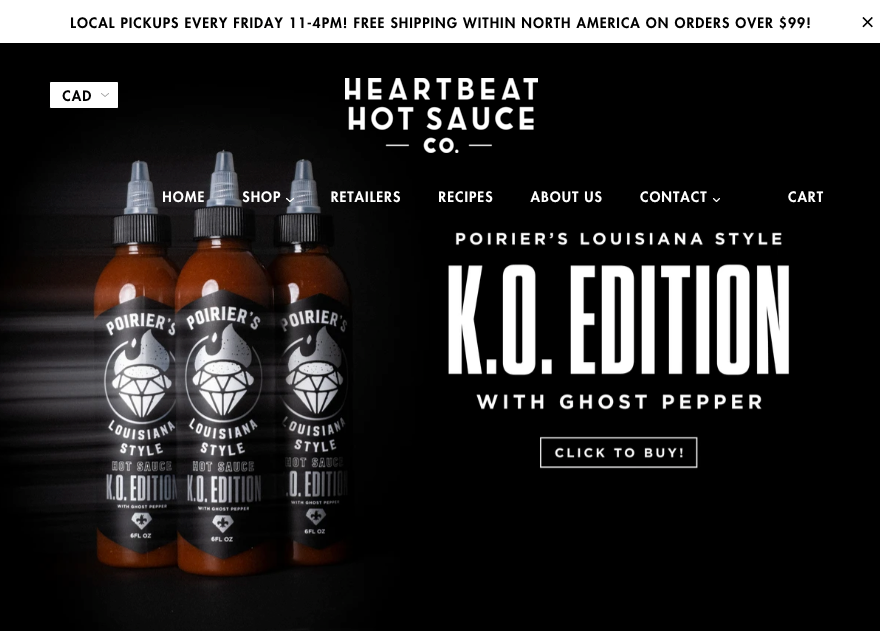
Based in Thunder Bay, Ontario, Heartbeat Hot Sauce develops, cooks, bottles, and distributes its own signature line of hot sauces. Heartbeat Hot Sauce offers staples like piri piri and Louisiana-style hot sauce, alongside more unique flavor combinations like pineapple and blueberry habanero.
A post shared by Heartbeat Hot Sauce Co.™ (@heartbeat_hotsauce)
The flavors in Heartbeat’s line of hot sauces hit all the right notes, blending familiarity with novelty. The brand also maintains a huge online community via Instagram, helping to build a stronger relationship with its audience. Chips, nuts, pretzels, popcorn, granola bars, or maybe a mixture of all of them—pre-packaged snack products come limitless varieties.
Chips, nuts, pretzels, popcorn, granola bars, or maybe a mixture of all of them—pre-packaged snack products come limitless varieties.
Pre-packaged snacks are a staple of both adventurous outdoor excursions and monotonous late-night cravings—and nearly all of us have a fondness for them.
The market for savory snacks in North America is expected to reach $59.25 billion by 2028, meaning there’s a lot of room for new merchants with a unique product.
Benefits
Challenges
Get inspired: Snaffling Pig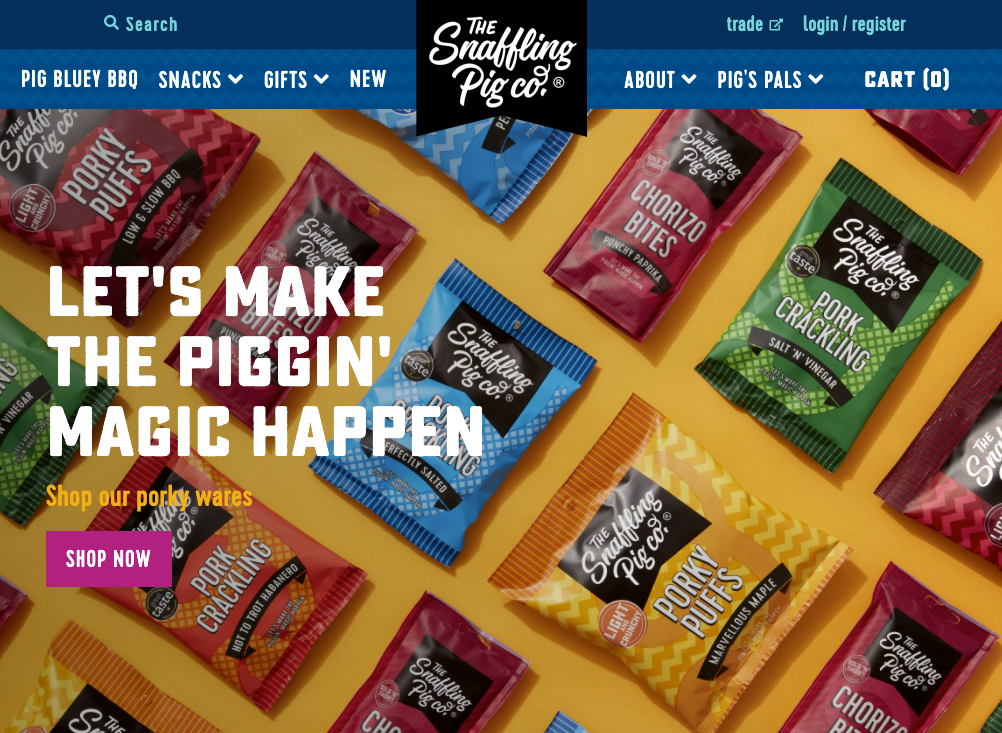
Based in the United Kingdom, The Snaffling Pig Co. sells all kinds of pre-packaged snacks, but its signature is its pork crackling—a chip-esque snack made from dried pork meat and seasonings.
The Snaffling Pig also sells nuts, pork rinds, chorizo bites, and even beers and ciders, flavored to compliment its snacks.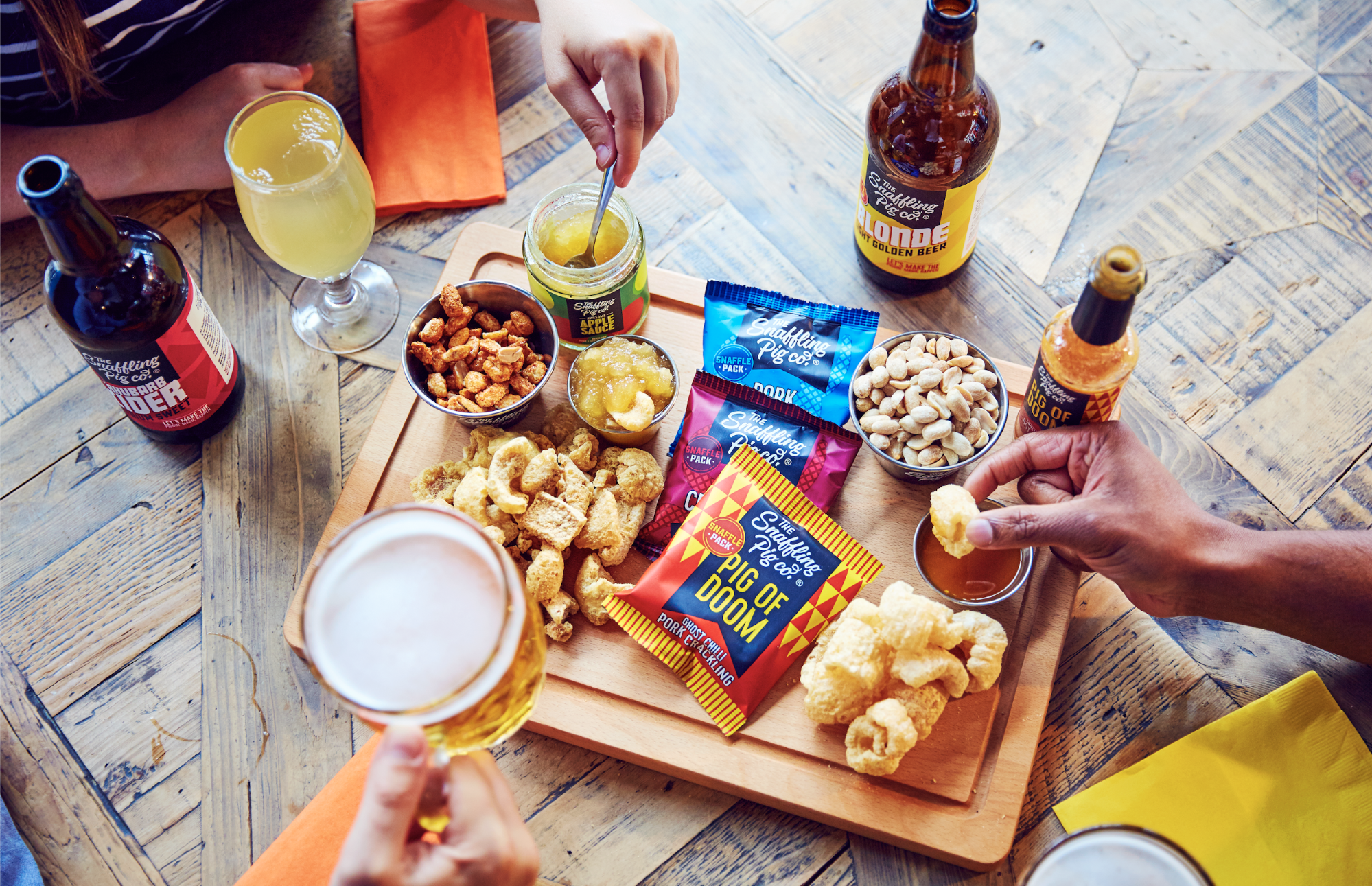
What brings these elements together is the Snaffling Pig’s branding, which aims to recreate the flavors of casual pub food, drawing on its own nostalgic memories to create a sense of camaraderie with the brand.
So far, it appears to be a huge success. Snaffling Pig was named one of the UK’s fastest-growing food businesses in 2021, posting a compound annual growth rate of 35% over the past two years.  Every parent wants to give their child the best, most nutritious food there is. Why not cater to this huge market? Baby food is one of the easier things to make and sell and can be a great first-time home-based business.
Every parent wants to give their child the best, most nutritious food there is. Why not cater to this huge market? Baby food is one of the easier things to make and sell and can be a great first-time home-based business.
There’s also growth potential. Doctors recommend different types of foods for babies of different ages—starting with formula for newborns, mashed foods after about six months, and finally, softer solid foods for toddlers.
This opens up a lot of opportunities for cross-marketing and creating repeat buyers of those with growing children. With the global baby food market on track to grow to more than $277 billion by 2025, there’s lots of new customers on the way.
Benefits
Challenges
Get inspired: Fragola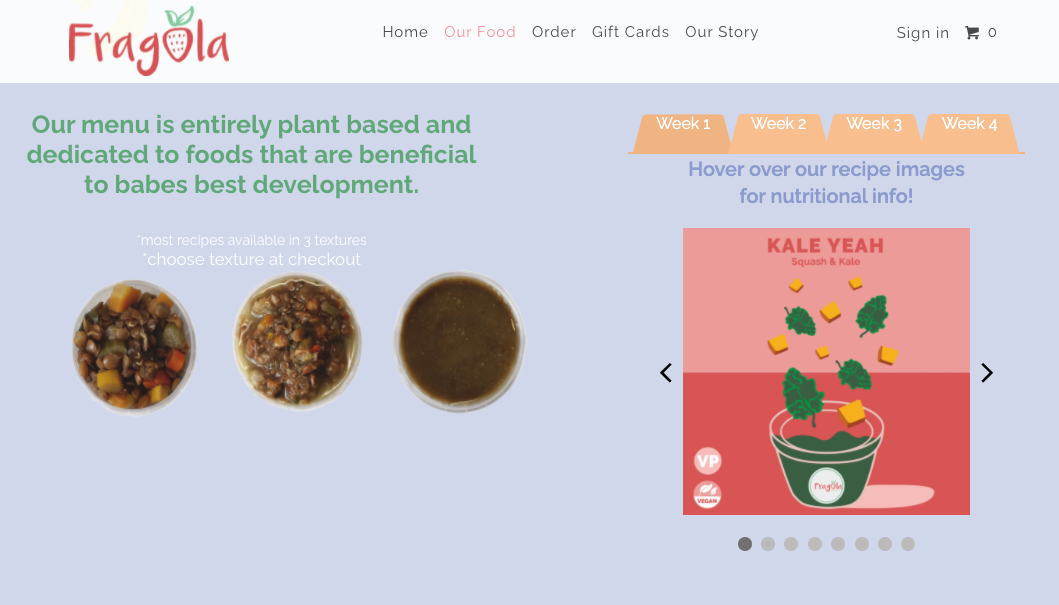
Fragola is a baby food brand based in Innisfil, Ontario. Fragola offers both one-time orders and baby food subscriptions that offer a new combination of flavors each week.
Fragola’s branding puts a lot of emphasis on nutrition and the freshness of its products. The first page of its order form breaks down the nutritional value of its products, and on-page copy often explores their reasons for selecting certain foods over others.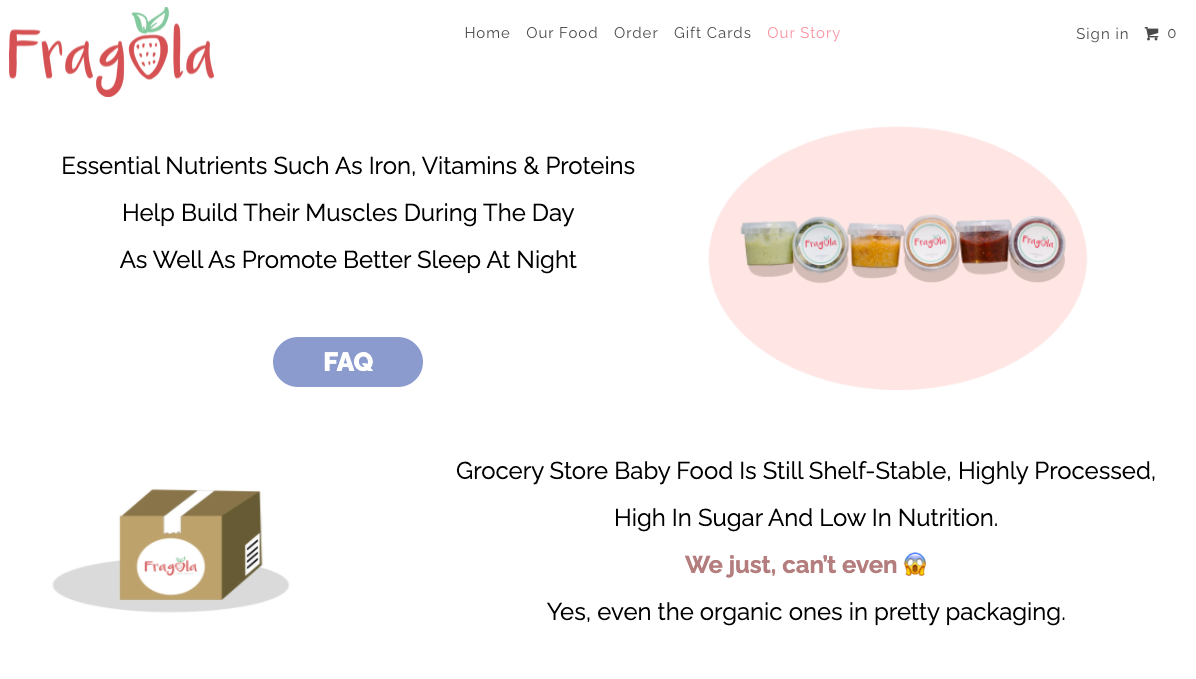
Fragola understands that it needs to establish trust with its customers right away. Parents are immediately made aware of the care put into selecting the best ingredients, which already helps set it apart from larger brands.
But what really helps set Fragola apart are simple acts of kindness. When the covid pandemic hit, Fragola rallied its social media followers into helping less fortunate parents, asking them to purchase gift cards that would be matched with a family in need.
Customers don’t forget generosity like this. Giving back to the same community that helps your business thrive goes a long way in establishing meaningful relationships. Jams and jellies are a great low-cost business to start for entrepreneurs interested in growing their own fresh produce. At-home jam jarring machines are relatively inexpensive, and growing your own ingredients will add a personal touch to your brand that will resonate with customers.
Jams and jellies are a great low-cost business to start for entrepreneurs interested in growing their own fresh produce. At-home jam jarring machines are relatively inexpensive, and growing your own ingredients will add a personal touch to your brand that will resonate with customers.
On top of this, farmer’s markets are a great place to meet potential customers in person. While the volume of customers might be smaller than online, face-to-face sales opportunities tend to provide more value in terms of customer loyalty and word-of-mouth sales.
Benefits
Challenges
Get inspired: Fruits of the Forage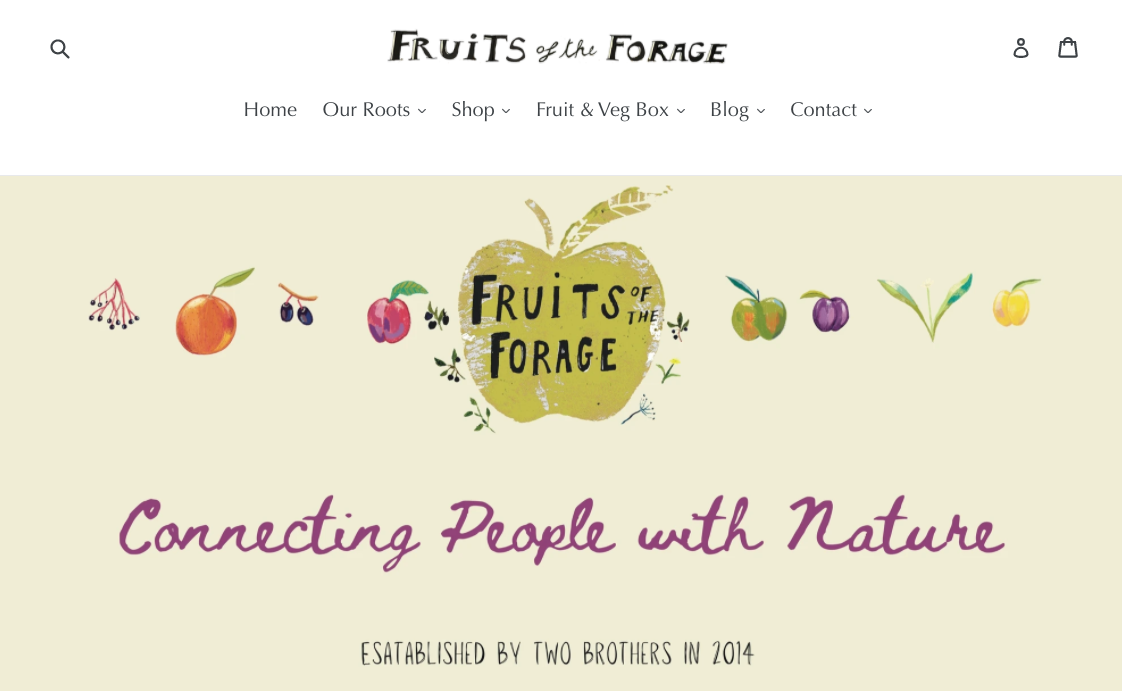 Fruits of the Forage is a UK-based retailer of jams, jellies, marmalades, sauces, and other fresh preserves.
Fruits of the Forage is a UK-based retailer of jams, jellies, marmalades, sauces, and other fresh preserves.
Alongside its line of products, Fruits of the Forage offers a fresh fruit subscription service, where a new variety of fresh-grown fruits and vegetables are shipped out to subscribers every week.
For smaller brands, setting yourself apart from your larger competitors is crucial. That’s why Fruits of the Forage bases its branding around the freshness of its ingredients and the championing of local produce, highlighting what makes the brand different. Organic foods are foods produced using natural fertilizers, as opposed to chemical pesticides. Official standards can vary between organizations and regions, but they all place emphasis on the recycling of resources, ecological balance, and long-term sustainability.
Organic foods are foods produced using natural fertilizers, as opposed to chemical pesticides. Official standards can vary between organizations and regions, but they all place emphasis on the recycling of resources, ecological balance, and long-term sustainability.
Organic foods have grown incredibly popular in the past decade as the safety of pesticides has become an important concern for a lot of customers. You could sell raw, organic produce or use organic ingredients in your food products.
Benefits
Challenges Socializing over alcoholic beverages is a common pastime. They’re popular year round but still lend themselves well to seasonal promotions, with plenty of opportunities to test out new products.
Socializing over alcoholic beverages is a common pastime. They’re popular year round but still lend themselves well to seasonal promotions, with plenty of opportunities to test out new products.
Like with jams and jellies, selling wine can give you the opportunity to grow your own fresh ingredients, and wine-tasting events can be a great way to establish meaningful customer relationships.
With beer, craft breweries (sometimes called microbreweries) have become increasingly popular in the past couple of years, so beer connoisseurs place a lot of value in exclusivity—something that gives smaller brands an advantage.
Benefits
Challenges
Get inspired: Haus Haus is a California-based brand specializing in apéritifs—alcoholic beverages that are rich in flavor, lower in alcohol, and meant to be served before a meal.
Haus is a California-based brand specializing in apéritifs—alcoholic beverages that are rich in flavor, lower in alcohol, and meant to be served before a meal.
Haus isn’t shy about emphasizing the freshness of its products, using only natural ingredients, like locally sourced fruits, herbs, and botanicals.
A post shared by Haus (@drinkhaus)
Haus also keeps a vibrant community alive via Instagram, where it posts recipes and serving suggestions that keep its audience engaged. Content like this is great for building brand awareness and picking up new customers via social media.
You may have noticed from the examples above that food businesses thrive on cross promotion. Any product can be a jumping off point for a more involved brand, but it’s best to start with a singular goal in mind.
For example, your food truck could double as a catering business. You might sell baby food specifically for babies with certain dietary restrictions. Or, like the Snaffling Pig, you could sell a pre-packaged snack alongside a complimentary beverage.
We’ve written a more extensive guide on how to start a food business that’s worth checking out if you want to know the ins and outs of the food industry.
For now, here’s a quick overview:
1. Decide what kind of food product you will sell
Coming up with your first product can be tricky. There are so many options in the food industry, and it’s never easy knowing which product opportunities are the best. But the first question to ask yourself is: Does the idea excite me?
If the answer is no, then scrap it. Your passion for your own food business fuels its growth. No matter how good an idea may be, it won’t thrive if it’s not something you’re interested in. Once you’ve decided on your idea, it’s time to evaluate it.
2. Validate your product ideas
There are a number of ways to validate product ideas, but it’s important in the initial stages to make sure that there’s a potential market for your product. You’re going to be investing a lot of time and effort into your business, and it’s important to know that it has potential.
Try meeting directly with potential customers, doing taste tests, exploring the community around your product, researching customer pain points and market demands—anything to gain a deeper understanding of the potential for your idea.
3. Develop a business plan
Once you’ve validated your product idea, you’re ready to start crafting your business plan. A business plan is a written document that outlines your business’s products or services, how you’ll earn money, and your financing, staffing, logistics, and other vital details.
It may sound daunting, but a good business plan is crucial to starting yourself off on the right foot. If you’re looking for a breakdown of time-tested techniques used by successful business owners, make sure to check out our business plan template
4. Start building your brand
Branding is crucial to any business, but it’s especially important in the highly competitive food industry. Your branding will be what sets you apart from your competitors, so it’s important to craft a consistent visual message that sparks the interest of potential customers.
Check our guide on how to build a brand for an in-depth breakdown of how to find your target audience, learn about their needs and interests, and give your business a personality that resonates with them.
5. Start building your online store
Once you’ve developed your brand, you’re ready to start building your online store. Add your products, create your collections, and customize your theme in a way that harmonizes all the visual elements of your brand.
6. Find and grow your audience
Once your store is set up, it’s time to start bringing in customers. There are a lot of ways to build an audience, —such as organic social media content that engages your niche and paid ads that help widen the audience for your content.
You might consider working with social media influencers. Or maybe your business lends itself well to blog content that would be relevant to your audience. The best marketing strategies can differ based on your branding, audience, product, niche, and a host of other factors specific to your business. 
Food is a constantly evolving industry with a wide variety of products, a huge volume of customers, and endless options for scalability—regardless of your level of experience. That makes it a great business opportunity.
Few things are more fulfilling than growing a business in an industry that excites you. For foodies and at-home chefs everywhere, starting a food business is a great chance to make money doing what you love.
Illustration by Chris Gash
Any food business can have a high profit margin, but if you’re looking for a low-cost, low-risk food business idea with no overhead, check out our dropshipping guide.
Dropshipping is a business model that allows entrepreneurs to start an online business and sell products while working with a third-party that manufactures, stores, and ships your items directly to your customers.
There’s no best business for everyone, but on an individual level, it’s best to start a food business you’re passionate about—even if you might not have a high level of experience.
New skills can be learned and experience will come with time, but a founder’s passion for their business is crucial to success. Pick the type of business that excites you the most.
Any food can make money, but if you’re unsure if your idea has legs, it’s best to validate your product ideas by meeting directly with potential customers, addressing their pain points, and researching the audience around your product to see if there’s potential.
Keep up with the latest from Shopify
Get free ecommerce tips, inspiration, and resources delivered directly to your inbox.
By entering your email, you agree to receive marketing emails from Shopify.
popular posts
The point of sale for every sale.
popular posts
2020-05-01
2023-07-16
2023-07-07
2020-11-02
2023-09-05
2023-07-15
2021-08-26
2023-09-06
Subscribe to our blog and get free ecommerce tips, inspiration, and resources delivered directly to your inbox.
Unsubscribe anytime. By entering your email, you agree to receive marketing emails from Shopify.
20 Feb 2024
20 Feb 2024
19 Feb 2024
19 Feb 2024
19 Feb 2024
15 Feb 2024
15 Feb 2024
15 Feb 2024
Learn on the go. Try Shopify for free, and explore all the tools you need to start, run, and grow your business.
Try Shopify for free, no credit card required.


Leave feedback about this